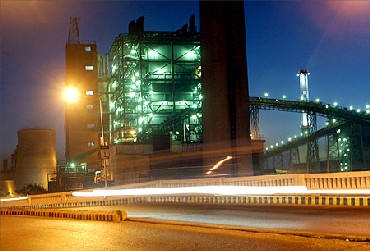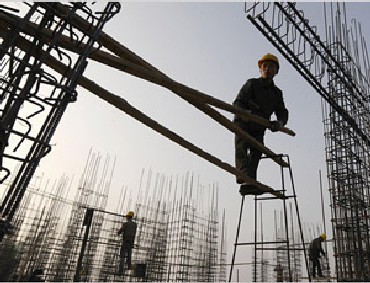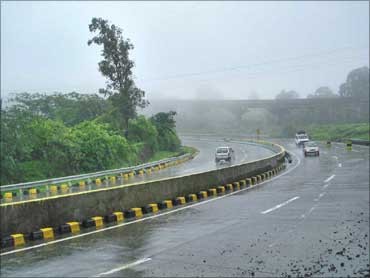 | « Back to article | Print this article |
New measures to boost infrastructure investment: FM
Energy and transport will get a lion's share of the Central Plan's outlay in the next fiscal even as Finance Minister Pranab Mukherjee on Monday announced several key initiatives for giving a boost to the infrastructure sector.
The government proposes to spend Rs 2.72 lakh crore on the transport and the energy sectors out of Rs 5.92 lakh crore earmarked in the Central Plan for 2011-12.
The allocation for the sector accounts for 45.95 per cent of the total plan outlay. This marks an increase of 9.68 per cent over the budget estimates of the previous year.
However, since the full outlay of Rs 2.48 lakh crore could not be spent last year, the increase in outlay in 2011- 12 was 21.43 per cent compared to the revised estimates for 2010-11.
Click NEXT to read more...
New measures to boost infrastructure investment: FM
Since investment in infrastructure is critical for maintaining the growth trajectory of the economy, the government intends to continue its focus on the sector.
Besides raising the outlays in the Central Plan, the Budget announced other important initiatives for funding the projects, including those in the private sector and the PPP models.
"Infrastructure is critical for our development," Finance Minister Pranab Mukherjee said while tabling the Budget in Parliament on Monday.
The major initiatives include creation of an infrastructure debt fund and raising the limit of foreign institutional investors (FII) in corporate bonds.
Click NEXT to read more...
New measures to boost infrastructure investment: FM
The government also announced issuance of tax-free bonds worth Rs 30,000 crore (Rs 300 billion) and extending income tax exemption on tax-saving infrastructure bonds up to a maximum of Rs 20,000 for one more year.
The Budget proposes to take the FII limit for investment in corporate infrastructure bonds to USD 25 billion and also permits foreign portfolio investment in SEBI-registered mutual funds.
With raising FII limit, Mukherjee said they will be eligible to invest up to USD 40 billion in corporate bonds, including a total of USD 25 billion in the infrastructure sector. " the FII limit for investment in corporate bonds, with residual maturity of over five years issued by companies in infrastructure sector, is being raised by an additional limit of USD 20 billion taking the limit to USD 25 billion," he said.
Click NEXT to read more...
New measures to boost infrastructure investment: FM
"This will raise the total limit available to the FIIs for investment in corporate bonds to USD 40 billion,"he added.
Besides, Mukherjee said since most of the infrastructure companies are organised in the form of SPVs, FIIs would also be permitted to invest in unlisted bonds with a minimum lock-in period of three years.
On introducing special infrastructure debt funds to attract foreign financing in the sector he said, the government proposes to create special vehicles in the form of notified infrastructure debt funds and "subject interest payment on the borrowings of these funds to a reduced withholding tax rate of 5 per cent instead of the current rate of 20 per cent."
Click NEXT to read more...
New measures to boost infrastructure investment: FM
Besides, it proposes to exempt the income of the fund from tax, he said, adding, to promote savings and raise funds for infrastructure, an additional deduction of Rs 20,000 for investment in long-term infrastructure bonds as notified by the government in 2010-11 will be extended for one more year.
"In order to give a boost to infrastructure development in railways, ports, housing and highways development,I propose to allow tax free bonds of Rs 30,000 crore (Rs 300 billion) to be issued by various government undertakings in the year 2011-12."
Mukherjee said the Indian Railways Finance Corporation (IRFC) and National Highways Authority of India Limited (NHAI) will issue tax-free bonds of Rs 10,000 crore each, while tax-free bonds worth Rs 5,000 crore (Rs 50 billion) each will be issued by HUDCO and the port sector, respectively.
Click NEXT to read more...
New measures to boost infrastructure investment: FM
Besides, he said the India Infrastructure Finance Company Limited (IIFCL) set up to provide long-term financial assistance to projects in the sector, is expected to disburse a cumulative of Rs 20,000 crore (Rs 200 billion) by March 31, 2011 and Rs 25,000 crore (Rs 250 billion) by March 31, 2012.
Earlier, lauding the public-private-partnership (PPP) model being implemented for creation of public sector assets, he said that the government will come up with a comprehensive policy that can be used by the Centre and the state governments for further developing PPP.






